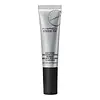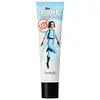What's inside
What's inside
 Key Ingredients
Key Ingredients

 Benefits
Benefits

 Concerns
Concerns

 Ingredients Side-by-side
Ingredients Side-by-side

Water
Skin ConditioningDimethicone
EmollientMethyl Trimethicone
Skin ConditioningVinyl Dimethicone/Methicone Silsesquioxane Crosspolymer
Dimethicone/Vinyl Dimethicone Crosspolymer
Skin ConditioningButylene Glycol
HumectantHamamelis Virginiana Water
AstringentCI 77220
Cosmetic ColorantIsononyl Isononanoate
EmollientAmmonium Acryloyldimethyltaurate/Vp Copolymer
Salix Nigra Bark Extract
Skin ProtectingLactobionic Acid
BufferingTocopheryl Acetate
AntioxidantSodium Hyaluronate
HumectantLaminaria Saccharina Extract
Skin ProtectingEcklonia Cava Extract
Skin ConditioningButyl Avocadate
Skin ConditioningPolyglyceryl-3 Disiloxane Dimethicone
Skin ConditioningPolyglyceryl-3 Polydimethylsiloxyethyl Dimethicone
Skin ConditioningEthylhexylglycerin
Skin ConditioningIsohexadecane
EmollientHydrolyzed Soy Protein
HumectantAcetyl Glucosamine
Skin ConditioningZinc PCA
HumectantPropanediol
SolventSodium Chloride
MaskingAcrylamide/Sodium Acryloyldimethyltaurate Copolymer
Emulsion StabilisingSynthetic Fluorphlogopite
Hydroxyapatite
AbrasiveSilica
AbrasiveNylon-12
Polysorbate 80
EmulsifyingLauryl Methacrylate/Glycol Dimethacrylate Crosspolymer
Coconut Acid
CleansingSalicylic Acid
MaskingParfum
MaskingBHT
AntioxidantTocopherol
AntioxidantPhenoxyethanol
PreservativeBenzoic Acid
MaskingZinc Oxide
Cosmetic ColorantWater, Dimethicone, Methyl Trimethicone, Vinyl Dimethicone/Methicone Silsesquioxane Crosspolymer, Dimethicone/Vinyl Dimethicone Crosspolymer, Butylene Glycol, Hamamelis Virginiana Water, CI 77220, Isononyl Isononanoate, Ammonium Acryloyldimethyltaurate/Vp Copolymer, Salix Nigra Bark Extract, Lactobionic Acid, Tocopheryl Acetate, Sodium Hyaluronate, Laminaria Saccharina Extract, Ecklonia Cava Extract, Butyl Avocadate, Polyglyceryl-3 Disiloxane Dimethicone, Polyglyceryl-3 Polydimethylsiloxyethyl Dimethicone, Ethylhexylglycerin, Isohexadecane, Hydrolyzed Soy Protein, Acetyl Glucosamine, Zinc PCA, Propanediol, Sodium Chloride, Acrylamide/Sodium Acryloyldimethyltaurate Copolymer, Synthetic Fluorphlogopite, Hydroxyapatite, Silica, Nylon-12, Polysorbate 80, Lauryl Methacrylate/Glycol Dimethacrylate Crosspolymer, Coconut Acid, Salicylic Acid, Parfum, BHT, Tocopherol, Phenoxyethanol, Benzoic Acid, Zinc Oxide
Water
Skin ConditioningGlycerin
HumectantSilica
AbrasiveSodium Acrylates Crosspolymer-2
AbsorbentButylene Glycol
HumectantPPG-24-Glycereth-24
EmulsifyingPhenoxyethanol
PreservativePEG-60 Hydrogenated Castor Oil
EmulsifyingCetyl Alcohol
EmollientTocopheryl Acetate
AntioxidantEthylhexylglycerin
Skin ConditioningXanthan Gum
EmulsifyingTocopherol
AntioxidantCI 19140
Cosmetic ColorantCI 42090
Cosmetic ColorantCI 77007
Cosmetic ColorantCI 77491
Cosmetic ColorantCI 77492
Cosmetic ColorantCI 77499
Cosmetic ColorantCI 77891
Cosmetic Colorant
 Reviews
Reviews

Ingredients Explained
These ingredients are found in both products.
Ingredients higher up in an ingredient list are typically present in a larger amount.
Butylene Glycol (or BG) is used within cosmetic products for a few different reasons:
Overall, Butylene Glycol is a safe and well-rounded ingredient that works well with other ingredients.
Though this ingredient works well with most skin types, some people with sensitive skin may experience a reaction such as allergic rashes, closed comedones, or itchiness.
Learn more about Butylene GlycolEthylhexylglycerin (we can't pronounce this either) is commonly used as a preservative and skin softener. It is derived from glyceryl.
You might see Ethylhexylglycerin often paired with other preservatives such as phenoxyethanol. Ethylhexylglycerin has been found to increase the effectiveness of these other preservatives.
Phenoxyethanol is a preservative that has germicide, antimicrobial, and aromatic properties. Studies show that phenoxyethanol can prevent microbial growth. By itself, it has a scent that is similar to that of a rose.
It's often used in formulations along with Caprylyl Glycol to preserve the shelf life of products.
Silica, also known as silicon dioxide, is a naturally occurring mineral. It is used as a fine, spherical, and porous powder in cosmetics.
Though it has exfoliant properties, the function of silica varies depending on the product.
The unique structure of silica enhances the spreadability and adds smoothness, making it a great texture enhancer.
It is also used as an active carrier, emulsifier, and mattifier due to its ability to absorb excess oil.
In some products, tiny microneedles called spicules are made from silica or hydrolyzed sponge. When you rub them in, they lightly polish away dead skin layers and enhance the penetration of active ingredients.
Learn more about SilicaTocopherol (also known as Vitamin E) is a common antioxidant used to help protect the skin from free-radicals and strengthen the skin barrier. It's also fat soluble - this means our skin is great at absorbing it.
Vitamin E also helps keep your natural skin lipids healthy. Your lipid skin barrier naturally consists of lipids, ceramides, and fatty acids. Vitamin E offers extra protection for your skin’s lipid barrier, keeping your skin healthy and nourished.
Another benefit is a bit of UV protection. Vitamin E helps reduce the damage caused by UVB rays. (It should not replace your sunscreen). Combining it with Vitamin C can decrease sunburned cells and hyperpigmentation after UV exposure.
You might have noticed Vitamin E + C often paired together. This is because it is great at stabilizing Vitamin C. Using the two together helps increase the effectiveness of both ingredients.
There are often claims that Vitamin E can reduce/prevent scarring, but these claims haven't been confirmed by scientific research.
Learn more about TocopherolTocopheryl Acetate is AKA Vitamin E. It is an antioxidant and protects your skin from free radicals. Free radicals damage the skin by breaking down collagen.
One study found using Tocopheryl Acetate with Vitamin C decreased the number of sunburned cells.
Tocopheryl Acetate is commonly found in both skincare and dietary supplements.
Learn more about Tocopheryl AcetateWater. It's the most common cosmetic ingredient of all. You'll usually see it at the top of ingredient lists, meaning that it makes up the largest part of the product.
So why is it so popular? Water most often acts as a solvent - this means that it helps dissolve other ingredients into the formulation.
You'll also recognize water as that liquid we all need to stay alive. If you see this, drink a glass of water. Stay hydrated!
Learn more about Water